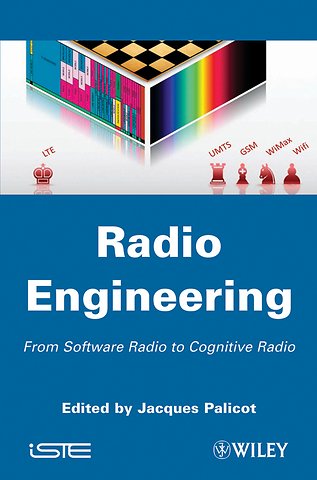Radio Engineering – From Software Radio to Cognitive Radio
From Software Radio to Cognitive Radio
Gebonden Engels 2011 9781848212961Samenvatting
Software radio ideally provides the opportunity to communicate with any radio communication standard by modifying only the software, without any modification to hardware components. However, taking into account the static behavior of current communications protocols, the spectrum efficiency optimization, and flexibility, the radio domain has become an important factor.
From this thinking appeared the cognitive radio paradigm. This evolution is today inescapable in the modern radio communication world. It provides an autonomous behavior to the equipment and therefore the adaptation of communication parameters to better match their needs.
This collective work provides engineers, researchers and radio designers with the necessary information from mathematical analysis and hardware architectures to design methodology and tools, running platforms and standardization in order to understand this new cognitive radio domain.
Specificaties
Lezersrecensies
Inhoudsopgave
<p>Acknowledgments xix</p>
<p>Introduction xxi</p>
<p>PART 1. COGNITIVE RADIO 1</p>
<p>Chapter 1. Introduction to Cognitive Radio 3<br /> Jacques PALICOT, Christophe MOY and Mérouane DEBBAH</p>
<p>1.1. Joseph Mitola s cognitive radio 3</p>
<p>1.2. Positioning 7</p>
<p>1.3. Spectrum management 9</p>
<p>1.4. A broader vision of CR 17</p>
<p>1.5. Difficulties of the cognitive cycle 21</p>
<p>Chapter 2. Cognitive Terminals Toward Cognitive Networks 23<br /> Romain COUILLET and Mérouane DEBBAH</p>
<p>2.1. Introduction 23</p>
<p>2.2. Intelligent terminal 25</p>
<p>2.3. Intelligent networks 32</p>
<p>2.4. Toward a compromise 35</p>
<p>2.5. Conclusion 40</p>
<p>Chapter 3. Cognitive Radio Sensors 43<br /> Renaud SÉGUIER, Jacques PALICOT, Christophe MOY, Romain COUILLET and Mérouane DEBBAH</p>
<p>3.1. Lower layer sensors 43</p>
<p>3.2. Intermediate layer sensors 57</p>
<p>3.3. Higher layer sensors 64</p>
<p>3.4. Conclusion 75</p>
<p>Chapter 4. Decision Making and Learning 77<br /> Romain COUILLET, Mérouane DEBBAH, Hamidou TEMBINE, Wassim JOUINI and Christophe MOY</p>
<p>4.1. Introduction 77</p>
<p>4.2. CR equipment: decision and/or learning 78</p>
<p>4.3. Decision design space 81</p>
<p>4.4. Decision making and learning from the equipment s perspective 82</p>
<p>4.5. Decision making and learning from network perspective: game theory 96</p>
<p>4.6. Brief state of the art: classification of methods for dynamic configuration adaptation 101</p>
<p>4.7. Conclusion 104</p>
<p>Chapter 5. Cognitive Cycle Management 107<br /> Christophe MOY and Jacques PALICOT</p>
<p>5.1. Introduction 107</p>
<p>5.2. Cognitive radio equipment 109</p>
<p>5.3. High–level design approach 122</p>
<p>5.4. HDCRAM s interfaces (APIs) 127</p>
<p>5.5. Conclusion 139</p>
<p>PART 2. SOFTWARE RADIO AS SUPPORT TECHNOLOGY 141</p>
<p>Chapter 6. Introduction to Software Radio 143<br /> Jacques PALICOT and Christophe MOY</p>
<p>6.1. Introduction 143</p>
<p>6.2. Generalities 145</p>
<p>6.3. Major organizations of software radio 150</p>
<p>6.4. Hardware architectures 153</p>
<p>6.5. Conclusion 159</p>
<p>Chapter 7. Transmitter/Receiver Analog Front End 161<br /> Renaud LOISON, Raphaël GILLARD, Yves LOUËT and Gilles TOURNEUR</p>
<p>7.1. Introduction 161</p>
<p>7.2. Antennas 161</p>
<p>7.3. Nonlinear amplification 172</p>
<p>7.4. Converters 185</p>
<p>7.5. Conclusion 205</p>
<p>Chapter 8. Transmitter/Receiver Digital Front End 207<br /> Jacques PALICOT, Daniel LE GUENNEC and Christophe MOY</p>
<p>8.1. Theoretical principles 208</p>
<p>8.2. DFE functions 210</p>
<p>8.3. Synchronization 229</p>
<p>8.4. The CORDIC algorithm 243</p>
<p>8.5. Conclusion 246</p>
<p>Chapter 9. Processing of Nonlinearities 249<br /> Yves LOUËT and Jacques PALICOT</p>
<p>9.1. Introduction 249</p>
<p>9.2. Crest factor of the signals to be amplified 250</p>
<p>9.3. Variation of crest factor in different contexts 252</p>
<p>9.4. Methods for reducing nonlinearities 264</p>
<p>9.5. Conclusion 269</p>
<p>Chapter 10.Methodology and Tools 271<br /> Pierre LERAY, Christophe MOY and Sufi Tabassum GUL</p>
<p>10.1. Introduction 271</p>
<p>10.2. Methods to identify common operations 273</p>
<p>10.3. Methods and design tools 280</p>
<p>10.4. Conclusion 297</p>
<p>Chapter 11. Implementation Platforms 299<br /> Amor NAFKHA, Pierre LERAY and Christophe MOY</p>
<p>11.1. Introduction 299</p>
<p>11.2. Software radio platform 299</p>
<p>11.3. Hardware architectures 300</p>
<p>11.4. Characterization of the implementation platform 309</p>
<p>11.5. Qualitative assessment 312</p>
<p>11.6. Architectures of software layers 313</p>
<p>11.7. Some platform examples 317</p>
<p>11.8. Conclusion 320</p>
<p>Chapter 12. General Conclusion and Perspectives 323</p>
<p>12.1. General conclusion 323</p>
<p>12.2. Perspectives 323</p>
<p>Appendix A. To Learn More 327</p>
<p>Appendix B. SR and CR Projects 333</p>
<p>Appendix C. International Activity in Standardization and Forums 339</p>
<p>Appendix D. Research at European and International Levels 345</p>
<p>Acronyms and Abbreviations 347</p>
<p>Bibliography 355</p>
<p>List of Authors 373</p>
<p>Index 375</p>
Rubrieken
- advisering
- algemeen management
- coaching en trainen
- communicatie en media
- economie
- financieel management
- inkoop en logistiek
- internet en social media
- it-management / ict
- juridisch
- leiderschap
- marketing
- mens en maatschappij
- non-profit
- ondernemen
- organisatiekunde
- personal finance
- personeelsmanagement
- persoonlijke effectiviteit
- projectmanagement
- psychologie
- reclame en verkoop
- strategisch management
- verandermanagement
- werk en loopbaan

